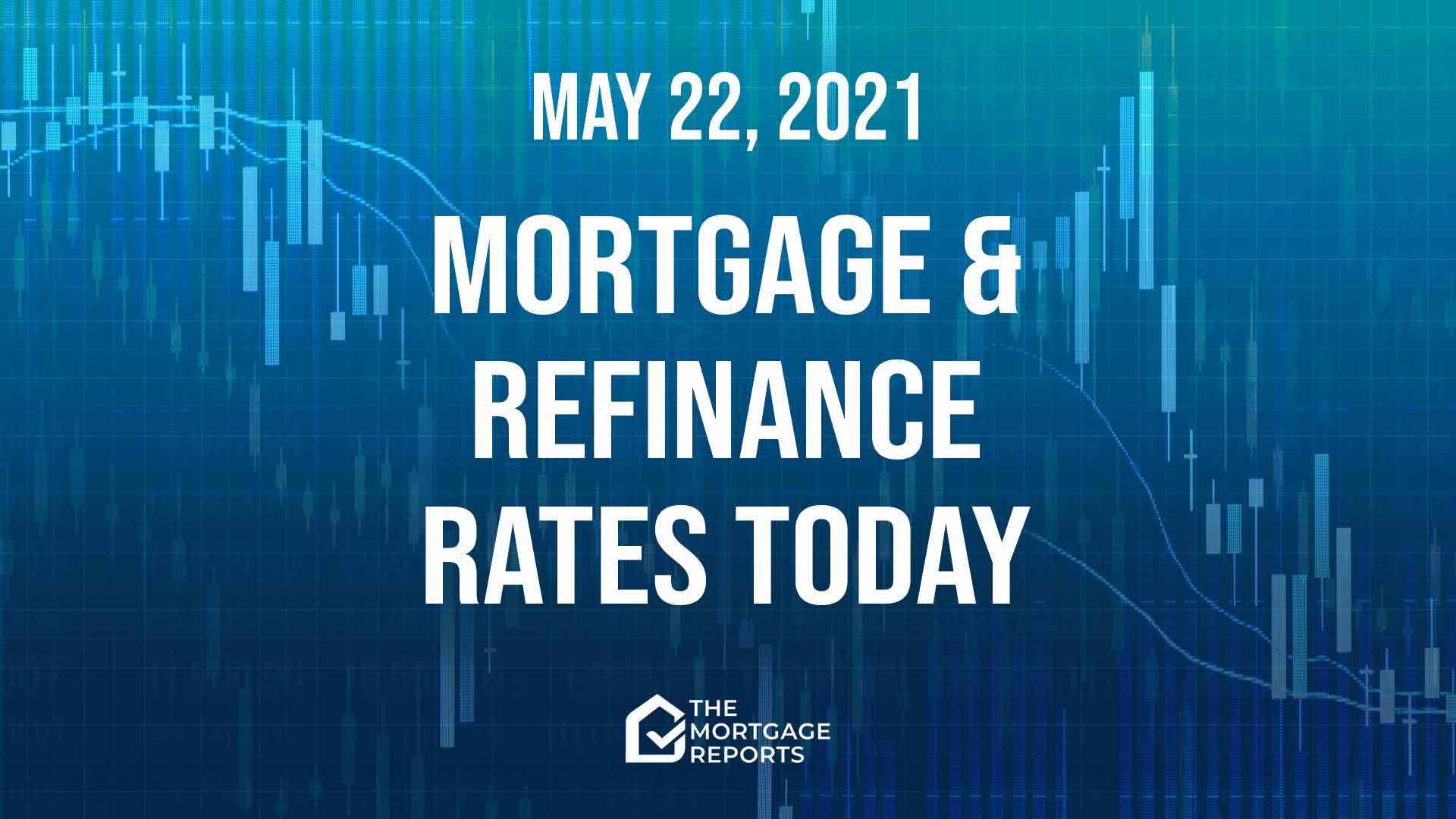
Today’s mortgage and refinance rates
Average mortgage rates barely moved on Friday. And that brought to an end a week in which they’d edged upward. But such a small change won’t have changed your life.
Yes, mortgage rates next week remain unpredictable. But, if I had to make a forecast (and I guess I should), I’d expect a further modest rise, just based on recent momentum.
Find and lock a low rate (May 24th, 2021)Current mortgage and refinance rates
| Program | Mortgage Rate | APR* | Change |
|---|---|---|---|
| Conventional 30 year fixed | |||
| Conventional 30 year fixed | 3.064% | 3.069% | -0.04% |
| Conventional 15 year fixed | |||
| Conventional 15 year fixed | 2.25% | 2.367% | Unchanged |
| Conventional 20 year fixed | |||
| Conventional 20 year fixed | 2.781% | 2.873% | -0.03% |
| Conventional 10 year fixed | |||
| Conventional 10 year fixed | 1.924% | 2.115% | +0.06% |
| 30 year fixed FHA | |||
| 30 year fixed FHA | 2.813% | 3.47% | Unchanged |
| 15 year fixed FHA | |||
| 15 year fixed FHA | 2.496% | 3.097% | Unchanged |
| 5 year ARM FHA | |||
| 5 year ARM FHA | 2.5% | 3.201% | Unchanged |
| 30 year fixed VA | |||
| 30 year fixed VA | 2.383% | 2.555% | +0.01% |
| 15 year fixed VA | |||
| 15 year fixed VA | 2.25% | 2.571% | Unchanged |
| 5 year ARM VA | |||
| 5 year ARM VA | 2.5% | 2.379% | Unchanged |
| Rates are provided by our partner network, and may not reflect the market. Your rate might be different. Click here for a personalized rate quote. See our rate assumptions here. | |||
COVID-19 mortgage updates: Mortgage lenders are changing rates and rules due to COVID-19. To see the latest on how coronavirus could impact your home loan, click here.
Should you lock a mortgage rate today?
Average mortgage rates edged higher again this week. And they remain near their highest level in more than a month.
I’m expecting to see more rises in coming weeks and months as the economic recovery gains traction. So I’d lock my rate now if I were you. But there are no certainties and you may prefer to follow your own instincts.
Still, my personal recommendations remain:
- LOCK if closing in 7 days
- LOCK if closing in 15 days
- LOCK if closing in 30 days
- LOCK if closing in 45 days
- LOCK if closing in 60 days
However, with so much uncertainty at the moment, your instincts could easily turn out to be as good as mine — or better. So be guided by your gut and your personal tolerance for risk.
What’s moving current mortgage rates
Do you remember the so-called taper tantrum of 2013? Unless you were caught up in it, there’s no reason why you should.
But it caused a sharp spike in mortgage rates. Indeed, those for a 30-year, fixed-rate mortgage jumped to 4.07% in June that year. And that was up from 3.54% in May, according to Freddie Mac’s archives. And they continued to climb, ending 2013 at 4.46%, and remaining above 4% until December 2014.
Now, I’m not in the business of giving history lessons. But you need to know about the events of 2013 because many are expecting a repeat this year or next
What is a taper tantrum and why does it matter?
Tapering in this context occurs when the Federal Reserve slowly reduces its purchases of assets. And the tantrum bit arises when markets don’t like what’s happening and throw their toys out of the stroller.
So, in 2013, after five years during which it bought almost $2 trillion in assets, mortgage rates shot up when the Fed announced it would gradually reduce its purchasing. How come? Well, those assets included mountains of mortgage-backed securities (MBSs). So the Fed was keeping mortgage rates artificially low.
Right now, the Fed is again buying assets — at a rate of $120 billion a month. And it’s likely the biggest purchaser of those MBSs and a big contributor to today’s low mortgage rates.
But, on Wednesday, the minutes of its last policy meeting revealed that some of its leaders wanted to soon raise the topic of a second taper. So there’s every reason to fear a second taper tantrum — and the sharply higher mortgage rates that one could bring.
More than a tantrum to fear
Sadly, we’re likely to see higher mortgage rates this year even if a taper tantrum is somehow headed off. See last week’s weekend edition for how a fear of future inflation and the possibility of an economic boom will likely push them higher anyway.
Unfortunately, nobody has a timetable for these events. We can see them coming but have no idea when they might arrive. And it’s that — and an abundance of caution — that has forced me to keep my float-or-lock recommendations on lock recently.
Of course, there’s always an outside chance of some extraordinarily harmful event choking the recovery and forcing the Fed to keep buying assets. And such a disaster would likely cause mortgage rates to fall again, perhaps to new all-time lows. But there’s more to fear from one of those than concerns about rates.
Economic reports next week
Chances are, you can relax next week right up until Friday. Most of the economic reports until then are relatively minor. However, any report can move markets if it contains shocking and unexpected data.
But pay attention on Friday. Because that brings the April figures for core inflation. And markets are currently obsessed with that. Personal income and consumer spending figures are also due that day.
But the others listed below are unlikely to set any pulses racing. Moreover, regular readers will know that markets have been ignoring most economic reports in recent weeks. So the effects of the following may be different from usual:
- Tuesday — March CoreLogic Case-Shiller national home price index. Plus the May consumer confidence index and April new home sales
- Thursday — April index of leading economic indicators. Also durable goods orders for April. Plus weekly new claims for unemployment insurance
- Friday — April figures for core inflation, personal income and consumer spending. Plus the May consumer sentiment index
So watch out for Friday.
Find and lock a low rate (May 24th, 2021)
Mortgage interest rates forecast for next week
Mortgage rates may inch higher again this week, although they remain essentially unpredictable. And I’ve little to go on — besides existing momentum — for that prediction.
Mortgage and refinance rates usually move in tandem. But note that refinance rates are currently a little higher than those for purchase mortgages. That gap’s likely to remain fairly constant as they change.
Meanwhile, a recent regulatory change has made most mortgages for investment properties and vacation homes more expensive.
How your mortgage interest rate is determined
Mortgage and refinance rates are generally determined by prices in a secondary market (similar to the stock or bond markets) where mortgage-backed securities are traded.
And that’s highly dependent on the economy. So mortgage rates tend to be high when things are going well and low when the economy’s in trouble.
Your part
But you play a big part in determining your own mortgage rate in five ways. You can affect it significantly by:
- Shopping around for your best mortgage rate — They vary widely from lender to lender
- Boosting your credit score — Even a small bump can make a big difference to your rate and payments
- Saving the biggest down payment you can — Lenders like you to have real skin in this game
- Keeping your other borrowing modest — The lower your other monthly commitments, the bigger the mortgage you can afford
- Choosing your mortgage carefully — Are you better off with a conventional, FHA, VA, USDA, jumbo or another loan?
Time spent getting these ducks in a row can see you winning lower rates.
Remember, it’s not just a mortgage rate
Be sure to count all your forthcoming homeownership costs when you’re working out how big a mortgage you can afford. So focus on your “PITI” That’s your Principal (pays down the amount you borrowed), Interest (the price of borrowing), (property) Taxes, and (homeowners) Insurance. Our mortgage calculator can help with these.
Depending on your type of mortgage and the size of your down payment, you may have to pay mortgage insurance, too. And that can easily run into three figures every month.
But there are other potential costs. So you’ll have to pay homeowners association dues if you choose to live somewhere with an HOA. And, wherever you live, you should expect repairs and maintenance costs. There’s no landlord to call when things go wrong!
Finally, you’ll find it hard to forget closing costs. You can see those reflected in the annual percentage rate (APR) you’ll be quoted. Because that effectively spreads them out over your loan’s term, making that higher than your straight mortgage rate.
But you may be able to get help with those closing costs your down payment, especially if you’re a first-time buyer. Read:
Down payment assistance programs in every state for 2021



